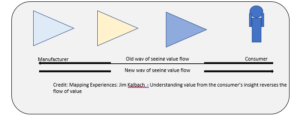- think outside-in to identify unique opportunities to become ambidextrous
The truth about any successful business or brand is the loyalty of its followers – customers. Any business that reciprocates this gesture will certainly be rewarded in a large measure. Some regard customers as part of a business configuration whereas, like all other components in that mix, they can ‘turn the right knobs’ to get the customer aligned. But Jim Kalbach, author of the best seller, ‘Mapping Experiences’, disagrees with this and I must add that I share the same opinion.
According to him, some executives think this way about the customer, “We have to figure out how to get customers for all they are worth”, the customers are as though you are wringing a towel, “if the towel gets dry, you have to squeeze harder. A good leader knows how to do that, and a good strategy makes it easier”. According to Kalbach, this view about customers is short-sighted. As our businesses grow, we must be wary of and deal with the danger of what experts call the misstep strategy myopia.

This is where the business doesn’t know what business it is in. I learned during my Master’s from research that Mcdonald’s, for example, is not necessarily in the food business. The model is one of real estate, and as franchisees buy into the model, McDonald’s thrives. Similarly, Kodak, which filed for bankruptcy in 2012, was judged by many to have failed because it missed digital technology. Kodak invented the first digital camera; therefore, this assertion is not true.
Kodak failed because (according to researchers) it had the myopic view that it was in the film business instead of the storytelling business. Leaders feared that digital technology will cannibalise profits. They believed they could protect their existing business through marketing and sales. So in short, for them, it was nearsightedness in strategy, not technology that led to their downfall.
To overcome this ‘nearsightedness’, we must develop a new way of seeing how current changes have made the consumer a powerful member of the business equation, thus, deserving great attention and focus in all aspects of business planning and execution. To align with this ‘new normal’, we must develop a new way of seeing, which requires several key responses including (and not limited to) reframing competition, creating shared value, reimagining value delivery, and organising for innovation.
Reframing competition
A typical way to segment the market from a traditional marketing perspective is by looking at the demographics in terms of age, income, race, marital status, etc.) or at purchasing bahaviour or company size. The setback here is that in doing so you create categories based on the perceptions of managers rather than the customer’s own needs and preferences. Unfortunately, the one-size-fits-all approach has gradually waned out of existence.
I walked into a shop in one of the shopping centres in Accra to buy a few things not long ago. While waiting at the counter to make my payment, I couldn’t help noticing that all the artworks on the walls in the shop portrayed men and women generations away from my age group and yet here I was buying a product targeted at some 20 to 35-year-olds. Catch my drift? Where competition is intense and consumers are careful about selecting preferences, you face an uphill task of sustaining their interest and choices if you go on this way.
Scott Cook, founder of the tax software giant Intuit, is quoted to have said once: “The greatest competitor (in tax software) …. was not in the industry. It was the pencil. The pencil is a tough and resilient substitute. Yet the entire industry had overlooked it”. Listening to customers and learning to address their needs intuitively can be a game-changer.
I read a story once when I was studying Business Economics years ago about a community that had no school within its geography and needed to travel a few miles to the next town to send their kids to school. Parents kept moaning about the distance; an entrepreneur saw the opportunity and decided to cash in. After some research, he was convinced that building a local school would be ideal for the residents and many would willingly patronise his school.
As it turned out – finishing his project, he realised just then that the school he was competing with had offered new incentives to parents and they were no longer willing to withdraw their wards to the new school as they found the new offer from the old school very attractive. Experts recommend that one way to understand the experience is to invest in diagrams of experience to give you deeper insights into the market from the perspective of the customer.
Create shared value
There is a paradigm shift from the long-held focus on shareholder value to one of shared value. As is the case with Mcdonald’s many other businesses have found that taking care of the customer’s needs yields great dividends. Take a company like Skype, traditionally they will offer a platform for virtual meetings. As a business, they will probably be interested in making their resource attractive to as many people to ensure that their shareholders are kept happy.
Turn this on its head and Skype is now in the classroom. Teachers can now use Skype to collaborate with other instructors around the world to design different learning experiences for students. To sum this up we would say that Skype is not only in the videoconferencing business, but they also provide educational collaboration opportunities for customers.
Some 5 years ago, I worked on a project with a company called Footprints Africa, an offshoot of a strategic investor from the UK, Stewart Investors. Their focus was to support SMEs in the developing world to become what they termed ‘Future Friendly’ businesses. Under the umbrella of this organisation, multinational companies provided support to help build capacities in small businesses so that they could grow and improve their business offerings to meet the needs of their multinational partners. Under this project, Nestle for example, worked with maize farmers helping them invest in best practices to enable them to increase their yields significantly, to make them major partners in Nestle’s value chain.
This simultaneously improved business processes in SMEs through knowledge sharing and networking. Nestle is not only in the business of producing food of high nutritional value, but also, they are giving back to the community by supporting SMEs and local farmers.
Reimagine value delivery
With the miniaturisation of the computer chip, it has become feasible to embed processing power into common objects. The Belkin cookpot takes a regular kitchen appliance and connects it to the internet. With an accompanying app, cooks can now control the device remotely. The Crackpot can now be linked to other devices inside and outside the home. This concept has birthed a common practice in Ghana where restaurants and food suppliers deliver services to clients from digital platforms through an app.
Coupled with this is the emergence of FinTechs which offer payment platforms to facilitate transactions; thus, making it convenient for customers to make orders from the comfort of their homes. Years ago in the UK, you could decide not to cook and just order from a local restaurant. This model gradually emerged into simple applications making life easier from the perspective of the customer. The good news is that technology has no boundaries.
Here in our ecosystem, we have seen the emergence of technology-managed processes lately. Customer Touchpoints are now a mix of technology, and brick and mortar. The COVID-19 pandemic opened many more opportunities for businesses to think of value from the perspective of the customer as opposed to the age-old practice of planning value from the boardroom and disseminating this to the frontlines. The emergence of the internet of things (IoT) has made service delivery a little more complicated. Collaboration driven largely by customer needs is now the way forward.
Organise for innovation
The age-old Darwinian view of innovation that the best new concepts will rise to the surface on their own no longer holds. Organisational structures have been major contributors to this status quo. In its place has now emerged what management researchers Charles O’Reilly and Michael Tuckman refer to as the ‘ambidextrous organisation.’
According to Wikipedia, this refers to an organisation’s ability to be efficient in its management of today’s business and also adaptable for coping with tomorrow’s changing demands. Just as being ambidextrous means being able to use both the left and right hand equally, organisational ambidexterity requires the organisations to use both exploration and exploitation techniques to be successful.
Experts opine that beyond being ambidextrous, organisations also need to organise around customer experience. Internal processes must mirror the customer journey as opposed to functional or technology lines. Build experience-centric teams where roles will span functional silos with the new arrangement driven largely by customer needs. With this new type of orientation, organisations are better placed to deliver solutions that match customer needs.
Strategy is usually created behind closed doors. Leadership meets in closed rooms or retreats to develop them usually with PowerPoint Presentations. They are then disseminated to different levels of the organisation where employees are required to ‘magically’ align with them. Often when the strategy fails, this is blamed on poor execution. This type of strategy is referred to by business consultants as the ‘Air Sandwich’ Strategy. To address this companies must view strategy as an inclusive endeavour with the customer’s interest as a central focus.
 |
The Writer is a Management Consultant (Change and Customer Experience). He can be reached on 059 175 7205, [email protected], https://www.linkedin.com/Kodwo Manuel |










